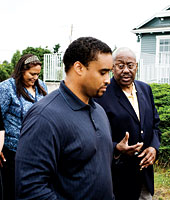Reconciling the Future
The Perkins Center Looks Ahead

From left: Mt. View Presbyterian Interim Pastor Lina Thompson, Tali Hairston, and Allen Belton of the Puget Sound Alliance. |
What’s next for the John Perkins Center for Reconciliation at Seattle Pacific University? Director Tali Hairston says that in the next few years the Center will sharpen its focus on four areas critical to community health:
Rising Violence
With gang violence on the increase in Seattle, Hairston plans to help develop and implement new violence-prevention strategies. “The answer is not just opening another gym,” he says. “Youth violence is an issue of tribalism. It’s gang warfare, neighborhood versus neighborhood. The question is, ‘How does the work of reconciliation apply in that context?’ We are looking for specific answers.”
Educational Standards
Some universities have dropped the traditional SAT requirement with the goal of enabling more ethnic minority students to apply for and enter college. While some view this as the “lowering of university standards,” others argue that different populations learn differently, and that the current K–12 system gives some ethnic groups unfair advantage over others as they prepare for higher education. “This is not just an issue of race,” says Hairston, “but also of gender. At the Perkins Center, we’re asking, ‘How can reconciliation be encouraged in ways that will bring about more equality within the educational system while keeping standards high?’”
Political Division
On the heels of a contentious election season, bridging political divisions in the community can seem impossible. However, Hairston believes the Perkins Center can play a role in helping individuals and organizations “see past” their political differences and find common values and priorities. In particular, Hairston says, by applying John Perkins’ people-focused model of ministry, the Perkins Center can help unite Seattle
in the cause of reconciliation and community development.
Immigration Issues
The Seattle area has one of the nation’s
largest populations of immigrants, and the Perkins Center is working closely with Ethnic Impact, a network of churches that support refugees and immigrants. The network is
the fruit of Ethnic America, a Billy Graham conference that took place in Seattle in
2006 and was sponsored in part by the
Perkins Center. “We’re attempting to build
a model for engagement in an immigrant community that is not homogenous,” says Hairston. “How do we accomplish reconciliation in a multiracial and multicultural
community? How do we help bring about understanding between the individual immigrant communities, and between the immigrant community and the population of Seattle? We’re still learning.”
Exclusive: Related Response Video
Director of the Perkins Center Tali Hairston shares what the Perkins Center is looking forward to in the 2008–09 academic year.
Return to top
Back to Features Home
|